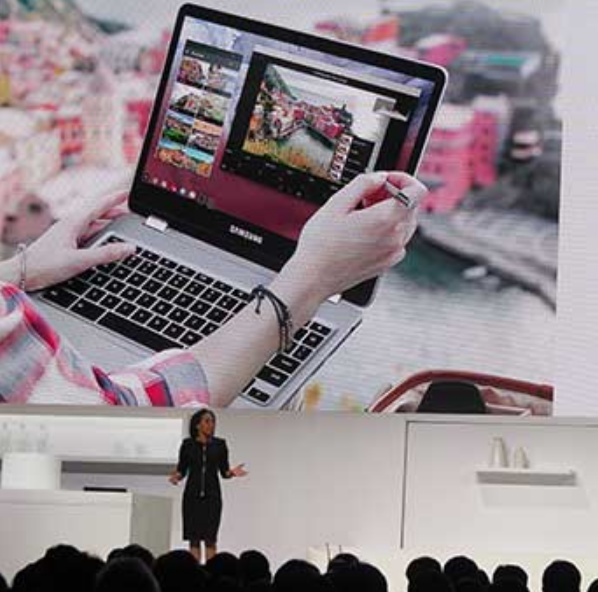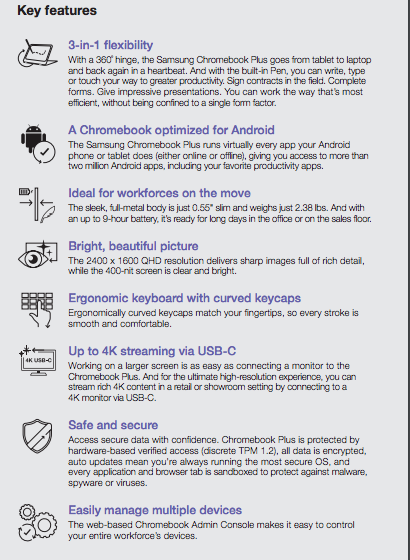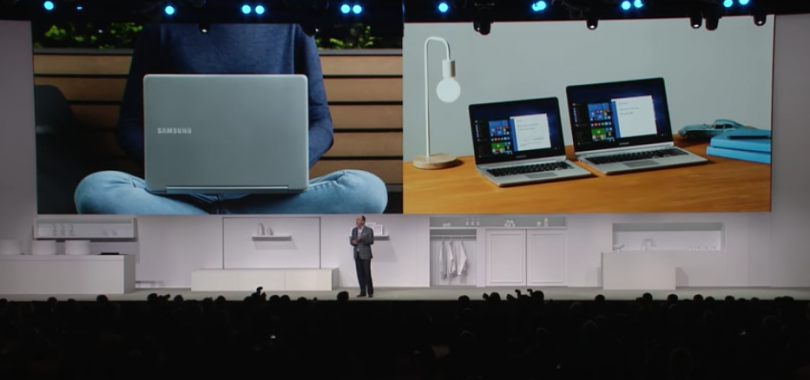aNewDomain  — Amid the torrent of CES 2017 news that’s already out, and the show just officially opened, it’s hard to settle on just one tech announcement as the best or most compelling one.
— Amid the torrent of CES 2017 news that’s already out, and the show just officially opened, it’s hard to settle on just one tech announcement as the best or most compelling one.
Well, for most reporters, that is.
For a tech reporter like me, though, it’s easy. And I say, forget Nvidia’s BB8 self-driving car, Faraday Future’s futuristic FF91 vehicle and even that whizzy Kuri home robot everyone’s been talking about. Whatever. Send that over to the general press.
Samsung’s Wednesday reveal of its new Samsung Chromebook models was the most compelling to come out of the show so far. Really. Here’s why.
Why so sexy?
Samsung has been whipping up anticipation around the launch of its new Chromebooks for awhile now. It easily could’ve overhyped this thing to the point where people would just be disappointed when Samsung did reveal it. But that didn’t happen here.
 Today’s announcement of the Samsung Chromebook — to ship as the ARM-based $449 Chromebook Plus in February and a souped-up, as yet Intel Core M3-based Pro later this spring — not only didn’t disappoint, it actually surprised.
Today’s announcement of the Samsung Chromebook — to ship as the ARM-based $449 Chromebook Plus in February and a souped-up, as yet Intel Core M3-based Pro later this spring — not only didn’t disappoint, it actually surprised.
That’s rare. And this is rarer: In specs, design, cost and, especially, its full-on integration of Android and the Chrome OS, the new Chromebook iteration somehow manages to emerge as a category first.
The big story here? Android-Chrome OS integration
Pure specs and great design are key, and I’ll get for those, but Samsung’s integration and work with Google to seamless integrate Android and Chrome OS functionality were the meat of this announcement, to this reporter at least.
“What we wondered is why you can’t enjoy your favorite Android apps on your notebook,” Samsung VP Alanna Cotton told the big crowd in Las Vegas today.
I am sure I am among millions of Android users who’ve wondered that exact same thing.
The new ARM-based Chromebook Plus as well as the Intel Core M3-based Chromebook Pro model — which are identical apart from their CPUs and graphics circuitry –are the first ever Chromebooks that let you run Android apps natively on the Chrome OS.
If that doesn’t sound like a big deal to you, you must not be an Android user.
 Chromebook users, you see, have long been stuck running a beta of Google Play on these systems, a solution that was clunky, slow and had limited app support. But according to Samsung and Google execs speaking today at CES, the two are now officially wed, an arrangement that brings a million plus Android apps to the platform — and with better performance than was possible before, too.
Chromebook users, you see, have long been stuck running a beta of Google Play on these systems, a solution that was clunky, slow and had limited app support. But according to Samsung and Google execs speaking today at CES, the two are now officially wed, an arrangement that brings a million plus Android apps to the platform — and with better performance than was possible before, too.
As the first ever Chromebook models with native Android app support, the Samsung Chromebook Plus and Pro models will be able to run everything from Google Movies to games to virtual and augmented reality apps to pretty high-end video editing software.
Because of that faster, native app support, Chromebooks — especially the higher end Intel Core M3-based Pro model due later this spring — will be able to compete with Windows and Apple systems on price and performance for the first time ever.
The merging of Chrome OS and Android was the real story out of this announcement. But it isn’t the whole story …
Great specs …
The two new Samsung Chromebook models differ only in terms of the processor inside and the graphics circuitry they offer. The less expensive one, the Chromebook Plus, is powered by an ARM hexacore processor and has no special graphics hardware. The Pro, on the other hand, is based on the same processor you see in Microsoft’s mid to high range Surface machines. That’s Intel’s Core M3 CPU. That system also uses Intel’s TK graphics circuitry, which will make it a better match for users who game a lot or otherwise deal with lots of graphics and video.
Otherwise, they’re identical. That’s a good thing. Both include a 12.3-inch, 2400 x 1600 pixel, quad HD LCD touchscreen, plus 4GB of RAM, 32GB of storage, a MicroSD slot and two USB (Type-C) ports that support 4K video output and charging.
And unlike most Chromebooks I’ve ever used, they won’t have that cheap feeling, either. These entries ditch the plastic and feature all-metal chassis cases. At just a hair under two pounds and just a hair over .5 inch thick when closed, they’re competitive weight and width-wise, too.
Until Samsung sends around review units for reviewers like me to test, performance still will be in question. In demos today at CES, though, performance looked snappy, colors looked vibrant and the videos on display ran smoothly. The proof will be in the testing, but spec-wise, they do seem to have the right stuff.
And a convertible notebook to tablet design
So, remember that quad HD LCD touchscreen I told you about? It’s got a 360-degree rotating hinge, the same thing you see in some higher-end convertible Windows laptops, That means you can quickly and easily switch between laptop mode and tablet mode.
 Also, and this is a first for a Chromebook, too, both systems will feature a built-in stylus as well as a new version of Google Keep that supports handwriting input. That app, it claims, will use machine learning to figure out and translate your handwriting pretty quickly. That’s another thing that I will be testing for sure in coming weeks and months.
Also, and this is a first for a Chromebook, too, both systems will feature a built-in stylus as well as a new version of Google Keep that supports handwriting input. That app, it claims, will use machine learning to figure out and translate your handwriting pretty quickly. That’s another thing that I will be testing for sure in coming weeks and months.
Pro or Plus?
That is the question, and I won’t have an answer till I test both systems.
At an SRP of $449, as you can see from BestBuy’s pre-order page, the lower-powered Samsung Chromebook Plus model for sure seems to offer a a ton of bang for the buck. And even without hands-on testing, that metal chassis, 360-hinge and the countless Android apps now available for it add up to one uniquely attractive offering.
 Remember, no Chromebook so far has delivered anything close to those capabilities, and definitely not for less than $500.
Remember, no Chromebook so far has delivered anything close to those capabilities, and definitely not for less than $500.
But I can’t help but keep my eye on the higher end Chromebook Plus model Samsung is promising to deliver later this spring. Pricing is still not set, but that Intel Core M3-powered Plus model and energetic Intel graphics hardware suggest it will at least be competitive, performance and feature wise, with lots of respectable Windows and Mac OS-based notebooks and laptops available today. It’s as thin and light, or better, than most of them. And its notebook-to laptop convertible design plus the handwriting support via Google Keep, if it works well, could compel a lot of people to make the Chromebook switch.
But we’ll see. The proof will lie in the testing. Stay tuned over the next few weeks as I begin testing these Samsung Chromebook models and put them through their paces for real.
For aNewDomain at CES 2017 in Las Vegas, I’m Mike Olsen.
Here’s the full version of the Samsung press conference execs held today at CES 2017.
And here’s the official spec sheet Samsung sent around to reporters after today’s Samsung Chromebook announcement.
Samsung Chromebook Specs – CES 2017 News by Gina Smith on Scribd
Also, since I mentioned it, maybe you should see that rocking little Invidia BB8 self-driving car. Here’s Invidia’s CES 2017 demo video.
Here’s Faraday Future’s new FF91 car, which it breathlessly claims “will revolutionize transportation with the first production car with retractable 3d lidar.”
Credits: Cover image: aNewDomain TV photo and screengrabs. Product shots: Samsung Electronics USA, All Rights Reserved.













